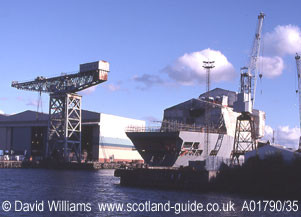The Govan shipyard has a long history - it was founded on Fairfield Farm in 1864 - and today it is the only merchant shipbuilder on the upper reaches of the River Clyde.
It was started by Charles Randolph and David Elder as Randolph, Elder & Company (later John Elder & Company) and built up a fine reputation for compound engines (which they had invented) and naval boat construction. It won many contracts from abroad including four ships for the American Confederates who used them as blockade breakers during the American Civil War (1861-5).
After Elder died in 1869, the yard was run by Sir William Pearce and it became known as the Fairfield Shipbuilding & Engineering Company; a long string of successful ships of various types allowed the yard to become one of the most important shipyards in the world. The yard produced many huge liners, including the Athenia (1922) and the Empress of Japan (1930), the fastest ship on the Yokohama to Vancouver route. It also built large naval ships such as the battleship Howe (1940) and the aircraft carrier Implacable (1942). Of all the ships, perhaps the strangest order was for the Livadia (1880) which was built as the Russian czar`s royal yacht; it was `turbot shaped`, 87m (285 feet) long and a massive 47m (153 feet) wide. A model of it exists in the Transport Museum.
The modern history of shipbuilding in Glasgow has been a sad story of contraction and crisis. In 1986 the yard became part of UCS (Upper Clyde Shipbuilders),(later emerging as Govan Shipbuilders, then Kvaerner Govan Ltd. It is now part of British Aerospace, as is the naval shipyard of Yarrows, just a little farther downstream. In recent years, its ships have included the large car ferry Norsea (1987) for North Sea Ferries and the remarkable Sea Launch Commander (1997) built for Sea Launch as a sea-going rocket assembly factory and control centre for launching satellites into space.
This article is based on the guidebook "The Glasgow Guide".

The Govan shipyard - the district`s only surviving shipyard.